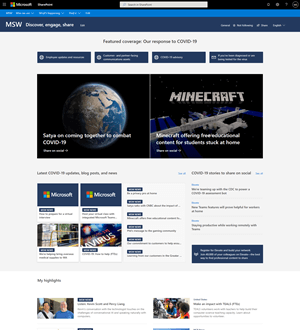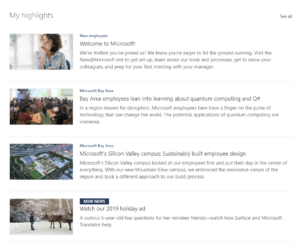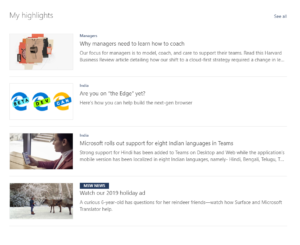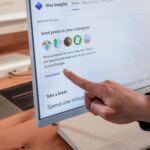
Editor’s note: This blog post has been updated to reflect how improvements in SharePoint in Microsoft 365 are enabling Microsoft to share news about COVID-19 and remote working with its employees in ways that were previously not possible.
Moving MSW, Microsoft’s internal news and information portal, to the latest version of SharePoint in Microsoft 365 is aiding the company as it provides COVID-19 guidance to its employees.
“We pretty dramatically rearranged our home page in a matter of hours to better be able to represent to employees our response to COVID-19,” Jaffe says. “This would have been impossible in the old SharePoint environment. It’s pretty amazing to have a tool flexible enough to allow us to make this kind of change this quickly.”

Microsoft finished moving MSW to SharePoint in Microsoft 365 in January, opening a number of new doors to the people who manage a website that is Microsoft’s front door for its employees.
“MSW is an out-of-the-box SharePoint home site for the entire organization,” Jaffe says. “Our vision is that it’s tailored to all of our employees based on where they work and who they work with, and is accessible on any device, anywhere.”
The changeover of the Microsoft home page to the most current version of SharePoint is a pivotal milestone on the company’s journey to migrate nearly 400,000 sites and portals to the web-based collaborative platform, moving from the classic publishing version of SharePoint to the latest “intelligent intranet” functionality.
That new functionality is enabling MSW to use SharePoint home-site technology to give employees a dynamic, personalized, and mobile experience—one that can change easily when the need arises.
On Monday, March 24th, Jaffe’s team decided that MSW’s home page needed to be reorganized to better show the content that Microsoft has available to employees on COVID-19 and on working remotely. In just hours, his team had redesigned the entire home page, providing employees with key COVID-19 resources, internal updates, and top news.
The move from then to now
Microsoft has moved 86 percent of its SharePoint team sites (332,446 sites and counting) and 76 percent of its SharePoint publishing portals (about 15,000 so far), but it has been slower to migrate its handful of larger-scale internal portals like MSW (short for Microsoft Web).
The company has reached a tipping point.
“We’re well on our way to finishing a migration that will allow us to significantly improve the end-to-end experience we offer our employees,” says Sam Crewdson, a senior program manager in Microsoft Digital Employee Experience.
This means that MSW is now accessible and mobile responsive by default. It also means that the number of customizations needed to manage the home page has been reduced from 13 to only 3.
“The fact that 86 percent of our sites are on the most current version of SharePoint in Microsoft 365 reflects a leap forward,” Crewdson says.
The Microsoft Employee Communications Team delayed moving the MSW home page to the new experience so that it could take advantage of search improvements, audience selectivity, and recently added SharePoint home-site capabilities. The vast majority of MSW’s pages—more than 99 percent—were moved to the most updated version of SharePoint one year ago.
“The fact that MSW has now made the move clears the path for legal, human resources, and other major portals to follow,” says Crewdson, whose team partnered with the Employee Communications Team to move the portal to the updated design. “Some of our big portals have already migrated.”
[Learn how Microsoft Digital Employee Experience supports the company’s use of SharePoint.]
Making MSW feel more like home

The new site, which 200,000 Microsoft employees, vendors, and partners call home, offers a more personalized experience while giving Jaffe and the Employee Communications Team a new set of tools to better communicate with employees and to assert their preferred branding look and feel.
“It’s about helping employees find information that’s relevant to them, to help them complete the tasks they want to complete,” Jaffe says. “Hopefully, that allows them to become more engaged and to spend less time searching.”
In the past, MSW tended to publish content that was Redmond-centric, meaning it was focused on the stories coming out of company headquarters.
“If you didn’t fit the profile of working in Redmond, you didn’t really feel like you were part of the company that was showing up on the pages of MSW,” Jaffe says.
That prompted company divisions and regional offices across the globe to create their own smaller portals that they used to share their local news and information with their people.
“We will use the updated MSW to unravel that trend,” Jaffe says. “We want teams from India, Australia, Silicon Valley, and everywhere else to localize the content that shows up on MSW for the people who work in their regions. We think of it as taking a One Microsoft approach to the intranet.”
Getting Microsoft’s large portals onto the latest feature set of SharePoint is a win for the product group, says DC Padur, a principal product manager in SharePoint.
“Having Microsoft launch this is a big deal, because it’s one of the biggest users of SharePoint in the world,” says Padur, who points out that his team learns a lot from how the company uses the product. “Customers ask, ‘How are you using it?’ They say, ‘Understanding how you use it will help me to understand how it would work for me.’”
Padur says being a SharePoint showcase works only if MSW is using the most current version of the product, which is now the case.
“We’re constantly adapting SharePoint,” he says. “Now our own IT team can adapt to new experiences as they come out and give us feedback that we can use for fine tuning to scale what works out to the entire world.”
New features pivotal in making MSW home page for all
When MSW debuted as the company’s home page in 1996, it was the definitive place where employees went to find information and do what they needed to do. Since then, employees get additional information that is specific to them, whether it be news, how to sign up for benefits in their home country, or the menu at their local café—all from numerous sources and accessible across various applications.
“We’ve had a home page with really limited audience customization,” Jaffe says. “We wanted to move to the point where we felt like we had a personalized home page built just for you. To do that, we needed to move from limited targeting to much finer-grained targeting.”
This means that customized content is aggregated for the user on a more central location based on their activities with content and other people throughout the company. Therefore, communication managers from particular parts of the company can now program content on MSW that will be seen by only the employees in their divisions. For example, the company’s sales team is now using MSW’s audience targeting feature to share guidance with sellers on how to support their customers and partners as they deal with COVID-19.
“Our new SharePoint home site allows that kind of customization,” Crewdson says. “Audience targeting has been democratized. Anyone can do it—it’s very easy.”
How does it work?

The MSW content team can push out content that’s relevant to everyone, but local content managers can change and adjust the content that shows up in their region or to employees in their particular division (what Xbox employees see will be different from that viewed by employees in the Office group). When it launches fully, local teams will be able to feed their local content into their version of MSW, eliminating the need for them to operate their own, separate portal.
Some news will be required reading for everyone, like announcements from senior leadership or broader company meetings; items like those will automatically be programmed to be seen by all. Also, by default, information like café menus and bus schedules will show only what’s available in an individual employee’s city or office—if you’re an employee in New York City, you won’t see shuttle options for Redmond.
Empowering the company to deliver relevant information to its employees is only half of it. The SharePoint news feature offers a personalized news feed in places like the SharePoint start page and the SharePoint mobile app. When a user follows a site, for example, news from that site is shown in their feed.
“In this way SharePoint can act as a news aggregator, centralizing the news from across all the sites that are important to you,” Crewdson says. “We believe, as the news features continue to be adopted, we’re going to have more informed users. People are more productive when they’re engaged.”
A communications manager in Microsoft Australia or the company’s regional office in Los Angeles would sign in to MSW, take a look at the feed coming in from headquarters in Redmond and add any local, role-related, or organizational content that they want to distribute for the employees who they’re trying to reach. On their end, it’s as easy as adding a headline, image, and description and then adding a group tag for each news item.
SharePoint value out-of-the-box
SharePoint offers much more than targeting content, Crewdson says.
“First of all, it’s dramatically cheaper and easier for us to build and manage on SharePoint now than in the past,” he says. “The product is really good out of the box. We don’t need to focus as much time and budget to design elements, mobile responsiveness, and accessibility. It hardly needs any customization, and that’s really exciting from an IT and life-cycle management perspective.”
For example, the previous version of MSW had 13 custom elements built and managed by an internal development team. This required that the team build individual parts for sections of MSW like the home page layout and for sections of the site like the news and events tabs. The new version, by comparison, was built almost entirely using out-of-box functionality, requiring only three customizations.
“Now those customizations all come built in, they’re high quality, fast to use, and are free,” Crewdson says. “They definitely come with some sizzle.”
As a result, the Employee Communications Team doesn’t need to budget for as much customization to build and operate MSW.
“The new SharePoint Framework is based on open standards and is very friendly,” he says. “You can develop on any JavaScript framework that you want. You can choose the language you want to use. You can write in a way that makes sense for you. It’s all about developing in SharePoint in a way that makes sense to you.”
It used to be that you needed a specialized SharePoint developer just to make your site look nice. And too often, time and budget restrictions curbed efforts to then make the portal responsive and accessible on mobile devices.
“A lot of teams that tried SharePoint 8 to 10 years ago found it was ugly by default,” Crewdson says. “It required developer interaction to make it pretty, and when you had to hire that developer, it was kind of hard to find that person—you had to go and find someone who was knowledgeable about doing it the SharePoint way.”
In addition to allowing site owners to create beautiful pages, SharePoint now is much more accessible.
“Engaging all Microsoft employees is part of our core mission. The new version is accessible by default,” Crewdson says. “In the old days, we had to build accessibility in. Now we get that out of the box. In fact, each engineering feature goes through both experience and accessibility reviews before anything moves into production.”
Learn how Microsoft Digital Employee Experience supports the company’s use of SharePoint.
To learn more about SharePoint, check out the SharePoint Admin documentation and SharePoint end-user documentation. Read this blog to catch up on what the SharePoint product group presented at Microsoft Ignite.
- See how work life is better at Microsoft with Viva.
- Learn how OneDrive for Business feature shifts how employees save files within Microsoft.
- The key to rolling out Microsoft Teams on home turf: Good governance.
Tags: digital transformation, SharePoint, WFH









